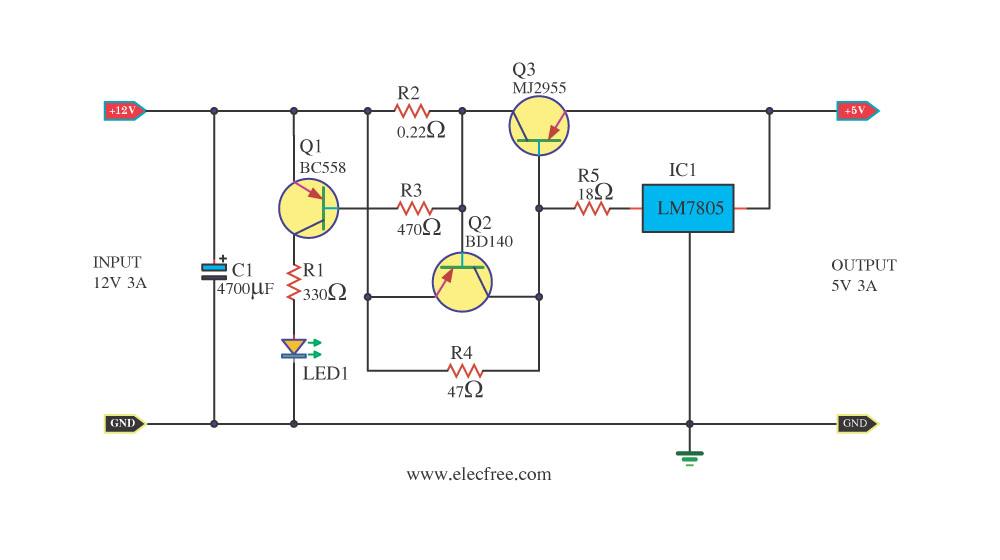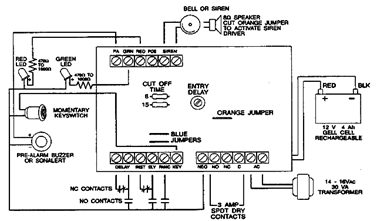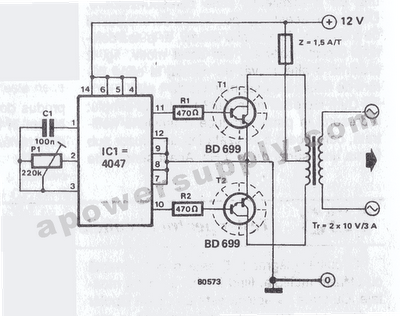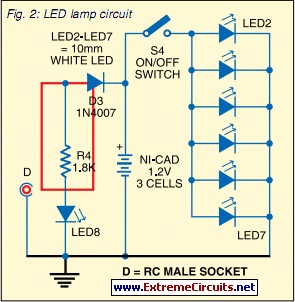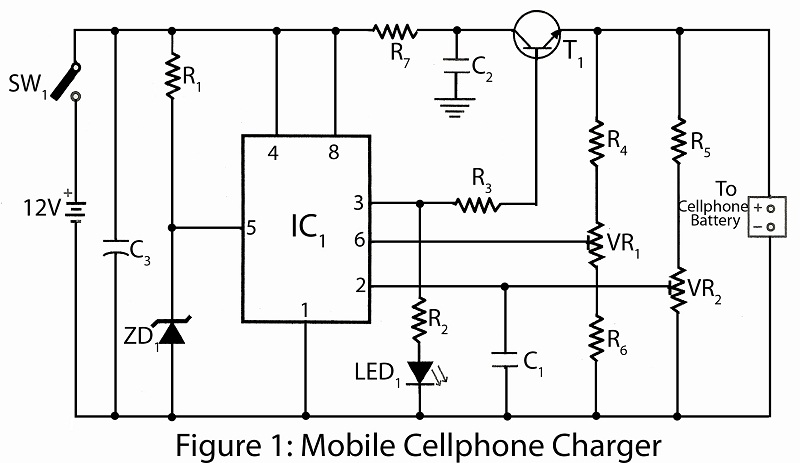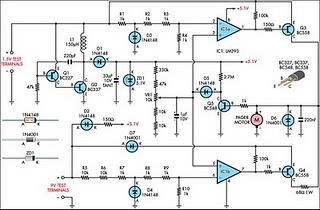
Automatic 12V Lead Acid Battery Charger
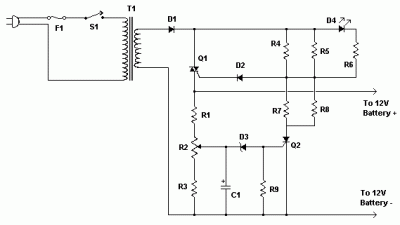
R2 must be adjusted to establish the correct finish charge voltage. Flooded and gel batteries are typically charged to 13.8V. For cycling batteries, such as AGM or gel types, battery manufacturers generally recommend a voltage range of 14.5V to 14.9V. To configure the charger, set the potentiometer to the midpoint, activate the charger, and then connect a battery to its output. Monitor the charge using a voltmeter until the battery attains the desired end voltage, and then adjust the potentiometer until the LED illuminates steadily. The charger is now configured. To accommodate multiple battery types, the potentiometer can be mounted on the front of the case with each position marked for the corresponding voltage. T1 is a transformer with a primary voltage suitable for the user's location (120V, 220V, etc.) and a secondary output of approximately 12V. Utilizing a higher secondary voltage (16V-18V) enables charging of 16V batteries, which are sometimes utilized in racing applications.
The described circuit involves a battery charger designed to accommodate various types of lead-acid batteries, including flooded, gel, and AGM configurations. The core of the design is a transformer (T1) that converts the mains voltage (either 120V or 220V) to a lower AC voltage, typically around 12V for standard charging applications. The transformer's secondary output can be increased to 16V-18V to cater to specialized 16V batteries often found in competitive racing environments.
The adjustable resistor, labeled R2, functions as a voltage divider, allowing the user to fine-tune the output voltage of the charger to meet the specific requirements of different battery types. For flooded and gel batteries, the output is set to approximately 13.8V, while AGM batteries, which are frequently cycled, require a higher voltage in the range of 14.5V to 14.9V. The potentiometer's midpoint setting serves as a starting point for configuration, ensuring that the user can easily make adjustments.
The incorporation of a voltmeter into the circuit is crucial for monitoring the charging process. By connecting the voltmeter to the charger's output, the user can observe the voltage increase as the battery charges. Once the desired voltage is reached, the potentiometer is adjusted until the LED indicator lights up steadily, signifying that the charger is correctly set for the battery type in use.
To enhance usability, the design allows for the potentiometer to be mounted externally on the charger case, with each voltage setting clearly marked. This feature simplifies the process of switching between different battery types, ensuring that users can quickly adjust the charger without needing to open the case.
Overall, this battery charger design emphasizes versatility and user-friendliness, making it suitable for a variety of applications, from standard automotive batteries to high-performance racing batteries. Proper adjustment and monitoring of the charging voltage are critical to maintaining battery health and optimizing performance.R2 will have to be adjusted to set the proper finish charge voltage. Flooded and gel batteries are generally charged to 13. 8V. If you are cycling the battery (AGM or gel) then 14. 5V to 14. 9V is generally recommended by battery manufacturers. To set up the charger, set the pot to midway, turn on the charger and then connect a battery to it`s output . Monitor the charge with a voltmeter until the battery reaches the proper end voltage and then adjust the pot until the LED glows steadily. The charger has now been set. To charge multiple battery types you can mount the pot on the front of the case and have each position marked for the appropriate voltage.
# T1 is a transformer with a primary voltage appropriate to your location (120V, 220V, etc. ) and a secondary around 12V. Using a higher voltage secondary (16V-18V) will allow you to charge 16V batteries sometimes used in racing applications. 🔗 External reference
The described circuit involves a battery charger designed to accommodate various types of lead-acid batteries, including flooded, gel, and AGM configurations. The core of the design is a transformer (T1) that converts the mains voltage (either 120V or 220V) to a lower AC voltage, typically around 12V for standard charging applications. The transformer's secondary output can be increased to 16V-18V to cater to specialized 16V batteries often found in competitive racing environments.
The adjustable resistor, labeled R2, functions as a voltage divider, allowing the user to fine-tune the output voltage of the charger to meet the specific requirements of different battery types. For flooded and gel batteries, the output is set to approximately 13.8V, while AGM batteries, which are frequently cycled, require a higher voltage in the range of 14.5V to 14.9V. The potentiometer's midpoint setting serves as a starting point for configuration, ensuring that the user can easily make adjustments.
The incorporation of a voltmeter into the circuit is crucial for monitoring the charging process. By connecting the voltmeter to the charger's output, the user can observe the voltage increase as the battery charges. Once the desired voltage is reached, the potentiometer is adjusted until the LED indicator lights up steadily, signifying that the charger is correctly set for the battery type in use.
To enhance usability, the design allows for the potentiometer to be mounted externally on the charger case, with each voltage setting clearly marked. This feature simplifies the process of switching between different battery types, ensuring that users can quickly adjust the charger without needing to open the case.
Overall, this battery charger design emphasizes versatility and user-friendliness, making it suitable for a variety of applications, from standard automotive batteries to high-performance racing batteries. Proper adjustment and monitoring of the charging voltage are critical to maintaining battery health and optimizing performance.R2 will have to be adjusted to set the proper finish charge voltage. Flooded and gel batteries are generally charged to 13. 8V. If you are cycling the battery (AGM or gel) then 14. 5V to 14. 9V is generally recommended by battery manufacturers. To set up the charger, set the pot to midway, turn on the charger and then connect a battery to it`s output . Monitor the charge with a voltmeter until the battery reaches the proper end voltage and then adjust the pot until the LED glows steadily. The charger has now been set. To charge multiple battery types you can mount the pot on the front of the case and have each position marked for the appropriate voltage.
# T1 is a transformer with a primary voltage appropriate to your location (120V, 220V, etc. ) and a secondary around 12V. Using a higher voltage secondary (16V-18V) will allow you to charge 16V batteries sometimes used in racing applications. 🔗 External reference
